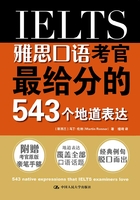
Proface
Thank you for buying this, my 7th book in China!
Since the publication of 456 Native Expressions that IELTS Examiners Love book, many things have happened:I have completed a book on IELTS writing(“Don't tell the IELTS examiner you have this book!”), gotten married and had a daughter! My best Chinese friend, “A.K.” whom you should remember from my first book, attended my wedding several months ago. Here he is at the reception jamming on a couple of tunes!

For those of you who already own a copy of the “456” book, I'd like to thank you for making that book a success! I received many positive responses from students who successfully increased their IELTS speaking scores using the skills in my book. This new book has even more useful material than the last one… 543 expressions, to be precise!
If you don't already have it,I recommend that you buy(or borrow!)a copy of my last book, as this new book is a companion piece—meaning,it incorporates and expands on the material from the first book.
In fact, this book is a concluding chapter, so to speak. With this book I complete my series of books on the IELTSS peaking Test,starting with“It's not what you say, it's how you say it” then “The structure of success” and now “456” and “543”. If you can remember and use the material in these four books I am positive you will be prepared for any eventuality and will be able to get a high score in the speaking test!
In this book I will be listing all of the common questions and topics which haven't been addressed in my previous books, as well as—of course—providing natural expressions and example responses for each one.
As the IELTS test is constantly changing and evolving,so too should the material that you use to prepare for the test. In this book, my aim is to focus on some of the more common new topics and questions, but also to prove a broad-spectrum of expressions that can be used any time now and in the future!
As with“543”throughout this book you will find new vocabulary and expressions highlighted in blue, all of which—if used in the speaking test—will increase both your vocabulary and fluency scores(refer to Chapter 8). As review, I have also tried to incorporate expressions from“456”in my example responses—see how many you can recognize!
Before we get started, a few quick points:
Keep in mind that all the expressions in this book can be cross-used. That means, all expressions can be used for any part of the test and for many related topics. For example, an expression related to“traffic”in Part 1 can also be used for a Part 2 topic about a“vehicle”or a Part 3 topic about environmental problems and so on.
Although I have attached certain expressions to specific questions, the most important thing to do is remember the expression and use it in as many different situations as you can.
Also, as I often remind students:
Please don't get hung up on telling the truth. Even if(for example) you don't have a brother or sister—who cares?—use the expression“sibling”because it will get you points! The examiner doesn't care if it's true or not;all that's important is that you show the examiner your vocabulary, grammar, pronunciation and fluency skills.
Alright, let's get the show on the road!
Martin Renner